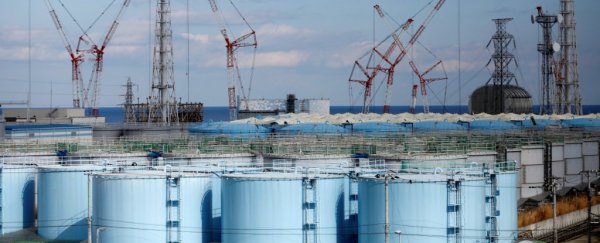On March 11, 2011, Japan was struck by the most powerful earthquake in the nation's history – a magnitude 9 temblor that triggered a tsunami with waves up to 133 feet (40 meters) high. The disaster set off three nuclear meltdowns and three hydrogen explosions at the Fukushima Daiichi Nuclear Power Plant.
Eight years later, Fukushima holds more than 1 million tons of contaminated water.
The water comes from two main sources. First, the tsunami caused the reactor cores to overheat and melt, so cleanup workers injected water into the cores to cool them. In the wake of the accident, groundwater also seeped in beneath the reactors and mixed with radioactive material.
To store this contaminated water, the plant currently has 1,000 sealed tanks. But the water is still accumulating. There's enough room to keep the liquid contained through summer 2022, but after that, there will be no space left.
At a news briefing in Tokyo, Japan's environment minister, Yoshiaki Harada, said that come 2022, "the only option will be to drain it into the sea and dilute" the contaminated water.
The Japanese government, however, is waiting on a verdict from a panel of experts before making a final decision about what to do with the water.
Meanwhile, the environmental group Greenpeace said in a statement that the "only environmentally acceptable option" would be to continue to store the water and filter it for contaminants.
But that would require more tanks and an expensive filtration process.
Dumping the water could reduce cleanup costs
Only two events have ever been designated "level 7" nuclear accidents by the International Atomic Energy Agency (IAEA): Fukushima and Chernobyl.
The majority of radiation released during the Fukushima disaster wound up in the Pacific Ocean, but the meltdown also forced the evacuation of more than 200,000 people from nearby areas – about 43,000 of whom still haven't returned.
The Japan Centre for Economic Research has estimated that the cleanup costs of the disaster could amount to $US660 billion.
Shortly after the tsunami, Fukushima plant workers constructed storage tanks to house the contaminated water used to cool the reactor cores. But they also had to contend with the radioactive groundwater, since cracks in the downed reactors' foundations allowed liquid to seep in from below.
This left cleanup crews with more dirty water to store and treat than they'd anticipated.
To purify all this water, plant workers at first used zeolites – volcanic materials that cling to a radioactive isotope called cesium. Then in 2013, they filtered the water for strontium, another toxic radioactive substance. But they had trouble filtering out an isotope called tritium, since it binds easily to water.
In 2016, the Japanese ministry concluded that none of the available methods for removing tritium would work on the Fukushima site.
Greenpeace later said the government had been deterred by the price tag of all the viable methods; one system from a company called Kurion would have cost around US$1 billion to set up, plus several hundred million dollars to operate each year.
'The sea is not a garbage dump'
Water containing tritium isn't very dangerous for humans – dumping tritium-laced water into the ocean is common practice for coastal nuclear plants. But it could endanger the local marine species, including fish, which provide a source of income for people living near the power plant.
In 2018, Fukushima's operator, the Tokyo Electric Power Company (Tepco), also revealed that isotopes like strontium lingered in the water, which meant that about 80 percent of the plant's treated water still had radiation levels above the government's standard for ocean dumping.
Some tanks had radiation levels that were 20,000 times greater than the government's safety standards.
Sending that contaminated water into the ocean could allow it to travel to nearby shores in South Korea, where it could contaminate that local seafood supply, too.
"The sea is not a garbage dump," Jan Hakervamp, a nuclear-energy expert at Greenpeace, told Business Insider.
"The sea is a common home for all people and creatures and must be protected."
This article was originally published by Business Insider.
More from Business Insider:
